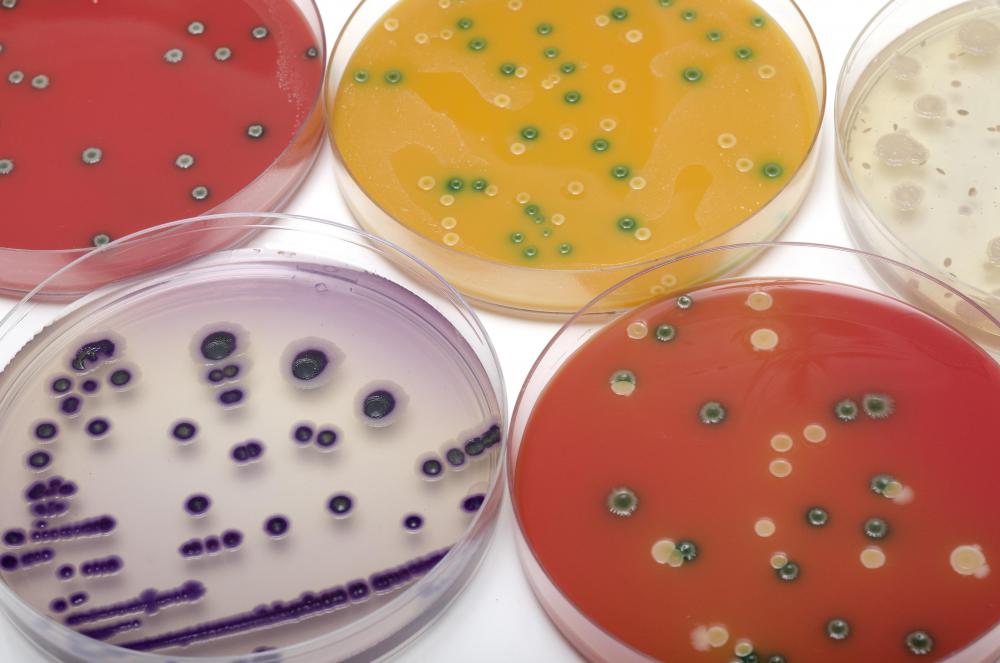At TheHealthBoard, we're committed to delivering accurate, trustworthy information. Our expert-authored content is rigorously fact-checked and sourced from credible authorities. Discover how we uphold the highest standards in providing you with reliable knowledge.
What is Spherical Bacteria?
Spherical bacteria are a group of bacterium characterized by a spherical shape, although they sometimes appear to be stretched or flat on one side. This group represents one of three morphologies in which these organisms are structured, the other two being rod-like bacteria and spiral bacteria. Individually, these bacteria are known as coccus, collectively as cocci, and as a class coccoid. The most commonly occurring specimens of spherical bacteria are Staphylococcus and Streptococcus, the latter being able to form long chains.
Generally speaking, bacteria differ from other living organisms in that they are single-celled and lack mitochondria and chloroplasts. They can also thrive in a variety of environments, including very extreme conditions. However, spherical bacteria are unique because they can exist singularly or in pairs, the latter being referred to as diplococci. They can also form chains of four (tetracocci), groups of eight or more (sarcinae), or arrange themselves in clusters (staphylococci).

In addition to shape, bacteria are classified according to the cellular wall structure. Specifically, a distinction is made between having a plasma membrane, or a plasma membrane with an outer membrane. The structure is determined by injecting an iodine dye in a test known as the Gram stain. Bacteria cells that retain the purple stain are said to be Gram positive. Spherical bacteria belong to this classification.

These bacteria can occur as aerobic or anaerobic organisms, labels that indicate whether oxygen is needed to survive. Since they are Gram positive, this type of bacteria resists being destroyed by heat or drying. This is because they have thicker cellular walls than other groups of bacteria. Unfortunately, this aspect offers some strains of spherical bacteria a defense from being attacked and destroyed by the body’s immune system.

Staphylococcus is found on the skin and in mucous membranes. While most species of this genus are completely harmless, some produce toxins that lead to illness. Food poisoning, for example, can be blamed on this species. Staphylococcus aureus is linked to Toxic Shock Syndrome, S. epidermidis to urinary tract infections, and Methicillin-resistant Staphylococcus aureus (MRSA) is a particularly robust species easily transmitted in hospital wards. This type of bacteria is also the culprit behind gonorrhea.

Streptococcus is also found on the skin, as well as in the mouth and intestinal tract. The species belonging to this class of spherical bacteria are linked to pneumonia, endocarditis, as well as meningitis. Since S. viridans is found in the mouth, it is to blame for most dental abscesses. In addition, S. agalactiae infects approximately one-third of women in their childbearing years and can be passed to infants during pregnancy.
AS FEATURED ON:
AS FEATURED ON:
















Discussion Comments
I would be curious to find out how a nail salon performs after a bacteria test. They are largely unregulated, and there are no standards for sterilizing pedicure and manicure equipment.
I was talking to a family friend who is a health professional and they said that there is a lot of interest in looking into the rates of infectious diseases and their relationship to nail salons. Pedicures and manicures often involve cutting cuticles, nails, grinding skin, etc., all of which can result in blood being drawn. My friend said that she wouldn't be surprised if the rate of bacterial and hepatitis infection were higher in these settings than normal.
@ GlassAxe- The MRSA staphylococcus bacteria is not only found in hospital environments dangerous outbreaks have originated in professional, collegiate, and high school locker rooms, jails, fitness centers, and community pools, even dorm rooms.
I don't like bacteria either so I make sure that I wear sandals when I shower in public locker rooms, I don't share towels, and I make sure my gym has disinfectant to wipe down the gym equipment between uses. The last thing I would want is to catch a bad strain of bacteria from trying to maintain my health.
Wow! I never realized that there were so many bacteria characteristics. This article really helped me understand why some types of bacterial infection are so hard to get rid of. The fact that drug resistant bacteria are so prevalent in hospitals honestly creeps me out. I have read about the horror stories of MRSA infections in hospitals that cause illness and even death.
Post your comments